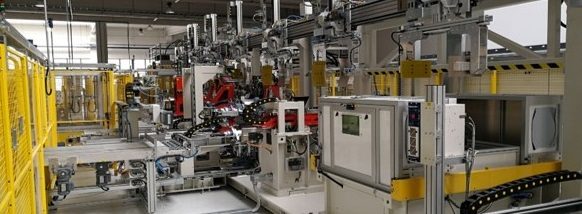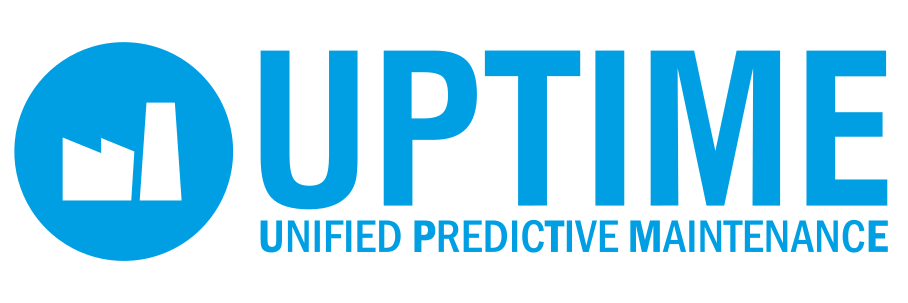UPTIME at ForeSee Cluster Webinar Predictive Maintenance European Success Stories...
Read MoreWhite Goods Appliance
Predictive Maintenance in Complex Automatic Production Line of White Goods
The Use Case deals with a complex automatic production line to produce drums for dryer. The product is basically a carbon steel cylinder used to keep and rotating clothes during drying stage. The equipment is a sequence of different steps involving many operations and requiring the synchronized action of mechanical, electrical, hydraulic and pneumatic tool and moving parts.
The process is the very first step for producing a dryer and has to guarantee a high overall efficiency. The maintenance plan is usually suggested by supplier based on the equipment ledger: a visual plan compiled according to our internal Whirlpool Production System. Currently only preventive and reactive maintenance are implemented. In the future vision the equipment systems will provide data and information about their current and future health status along with actions recommendations as well as appropriate visualizations.

Interview with Whirlpool Corporation
Interview with UPTIME project partner Pierluigi Petrali, Manager of Manufacturing R&D of Whirlpool Corporation, who is based in Italy. He shares his views with us on the benefits of predictive maintenance for Whirlpool’s complex automatic production line, which produces drums for clothes dryers. Moreover, he also provides some first-hand experiences and lessons learned from the recent implementation of the UPTIME Platform in the Whirlpool Business Case as well as some practical guidelines for manufacturers to get started with Predictive Maintenance. The Whirlpool use case deals with the newly installed production line for clothes dryers at their Polish factory in Lodz.
How has Whirlpool performed maintenance activities so far?
The drum production equipment is very complex, highly automated and critical from many perspectives. It is critical to ensure the highest possible quality of the drum, which is the core component of the clothes dryer. At the same time, it is vital to keep the production equipment running efficiently and keep costs under control. The equipment in question involves mechanical, hydraulic, electrical and electronic apparatuses. The maintenance of these assets has to be organized and managed at a World Class level.
Thus, maintenance activities in Whirlpool factories are organized according to World Class Manufacturing principles. In particular, Early Equipment Management, Autonomous Maintenance and Professional Maintenance pillars provide the guidelines and the roadmap to evolve towards Zero Breakdown Maintenance. Currently, we adopt reactive and preventive maintenance approaches using SAP-PM as a major supporting tool to manage the activities. Maintenance is managed mostly with internal resources. Whirlpool only requires support from external suppliers in major cases of severe damage.
How will UPTIME improve your maintenance service performance?
The capability of the UPTIME system to predict future failures of the Drum Line and to give indications about prognostic measures will modify the preventive maintenance plan allowing us to anticipate planned intervention on components, and thus reduce unexpected breakdowns and delay other interventions, and thus save money. The new preventive maintenance plan, modified according to predictions, will be more efficient and will impact on most important key performance indicators.
We expect the “Mean Time Between Failures” to increase thanks to the fact that some unforeseen breakdowns will be predicted by the system, allowing maintenance to act before the component breaks. Moreover, the “Mean Time to Repair” is expected to decrease thanks to the fact that the maintenance action will be planned in advance, and thus optimising equipment downtime. All these effects will also positively impact the total cost of maintenance thanks to an optimized management of spare parts, technicians scheduling and improved effectiveness.
What have been achieved so far after the first implementation phase of the UPTIME Platform in the Whirlpool Case?
In the first phase, we mainly concentrated our efforts in the implementation of analytical tool provided by the component UPTIME_ANALYZE. A broad spectrum of data are made available to UPTIME_ANALYZE and many different algorithms are evaluated in order to understand which are the best algorithms to detect the health status of our equipment. Moreover, UPTIME_FMECA analysis is performed, with main objective to address the monitoring of physical measures by means of sensors that could contribute to failure modes or causes prognosis and failure rate estimation. As a result, additional equipment sensors are installed in the Whirlpool drum production line.
What are the main challenges in the development and implementation phase and some lessons learned so far?
During the first implementation phase, we realized that finding the relevant piece of information hidden in large amounts of data turned out to be more difficult than initially thought.
One of the main learnings is that Data quality needs to be ensured from the beginning of the process. This implies spending some more time, effort and money to carefully select the sensor type, data format, tags, and correlating information. This turns to be particular true when dealing with human-generated data. It means that if the activity of input of data from operators is felt as not useful, time consuming, boring and out of scope, this will inevitably bring bad data.
Quantity of data is another important aspect as well. A stable and controlled process has less variation. Thus, machine learning requires large sets of data to yield accurate results. Also this aspect of data collection needs to be designed for example some months, even years in advance, before the real need emerges.
This experience turns out into some simple, even counterintuitive guidelines:
1. Anticipate the installation of sensors and data gathering. The best way is doing it during the first installation of the equipment or at its first revamp activity. Don’t underestimate the amount of data you will need, in order to improve a good machine learning. This of course needs also to provide economic justification, since the investment in new sensors and data storing will find payback after some years.
2. Gather more data than needed.
A common practice advice is to design a data gathering campaign starting from the current need. This could lead though to missing the right data history when a future need emerges. In an ideal state of infinite capacity, the data gathering activities should be able to capture all the ontological description of the system under design. Of course, this could not be feasible in all real-life situations, but a good strategy could be populating the machine with as much sensors as possible.
3. Start initiatives to preserve and improve the current datasets, even if not immediately needed. For example, start migrating Excel files distributed across different PCs into common shared databases, taking care of making a good data cleaning and normalization (for example, converting local languages descriptions in data and metadata to English).
Finally, the third important learning is that Data Scientists and Process Experts still don’t talk the same language and it takes significant time and effort from mediators to help them communicate properly. This is also an aspect that needs to be taken into account and carefully planned. Companies need definitely to close the “skills” gaps and there are different strategies applicable:
-
train Process Experts on data science;
-
train Data Scientists on subject matter;
-
develop a new role of Mediators, which stays in between and shares a minimum common ground to enable clear communication in extreme cases.
What are the next steps of the project for the Whirlpool Business Case?
In this second phase Whirlpool is planning to further enrich the dataset with newly installed sensors, to continue the evaluation of machine learning algorithms and to build basic rules to establish health status of the equipment.
PUBLIC DELIVERABLES
DELIVERABLE 5.1: Whirlpool Business Case, Conceptualisation and Evaluation Strategy
D5.1 provides comprehensive definition of the Whirlpool Business case, including as-is and to-be business processes and identification of Whirlpool stakeholders/business, system and technical requirements.
SCIENTIFIC PUBLICATIONS
-
Predictive Maintenance in a Digital Factory Shop-Floor: Data Mining on Historical and Operational Data Coming from Manufacturers’ Information Systems
Pertselakis M., Lampathaki F., Petrali P. (2019).. In: Proper H., Stirna J. (eds) Advanced Information Systems Engineering Workshops. CAiSE 2019. Lecture Notes in Business Information Processing, vol 349. Springer, Cham
RELATED ARTICLES
Insights & Feedbacks: UPTIME 1st Live Webinar – Lessons Learned & Best Practices in White Goods Industry
Insights and feedbacks UPTIME 1st Live Webinar Predictive Maintenance: Lessons...
Read MoreLIVE WEBINAR: 19 March 2020, 11:00 – 12:30 CET – UPTIME Predictive Maintenance – Lessons Learned and Best Practices in White Goods Industry
UPTIME Predictive Maintenance: Lessons Learned and Best Practices in White...
Read MoreUPTIME at 13th Maintenance Forum in Athens
UPTIME presented at 13th Maintenance Forum in Athens on 11th...
Read MoreUPTIME at Global Industrie, 6 March 2019, Lyon
UPTIME at the Nouvelles maintenances” (New Maintenance) Panel Discussion at...
Read More